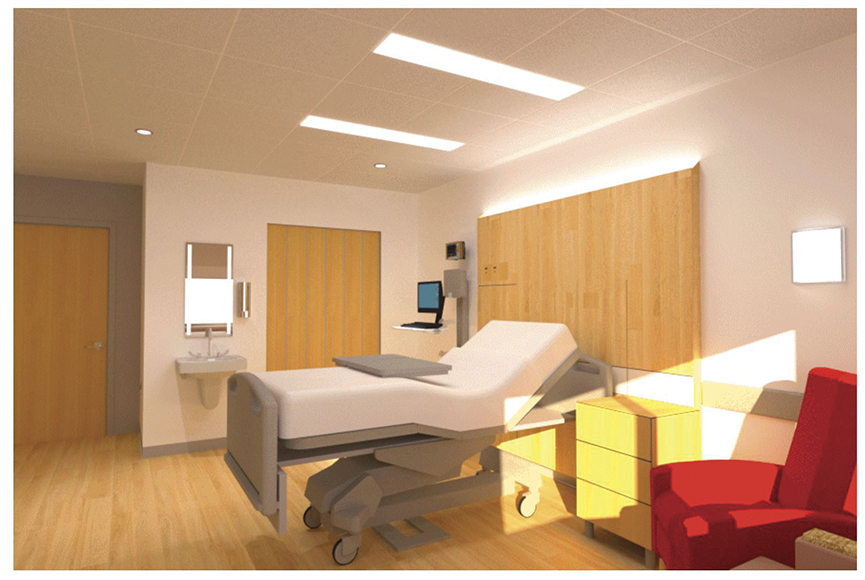Lighting designers can create natural-looking lighting options using various technologies and methods

Learning objectives
- Learn how correlated color temperature tuning is implemented.
- Understand the relationship between natural light and artificial lighting.
- Comprehend daylighting concepts and their effects on occupants.
The theory that lighting intensity and perceived color (also referred to as correlated color temperatures) of luminaires can affect our natural rhythms, mood and mental performance used to be hindered by previously available lighting technologies. The rapid evolution of solid-state lighting now allows lighting designers a seemingly unlimited number of options and strategies.
SSL has allowed for much more intense and sophisticated control scenarios. One of the modern ideas in lighting design is that controlling certain characteristics of a source (color, intensity, duration) may be associated with increased alertness, readiness of the body for sleep, improved moods, increased visual acuity and even boosted mental performance.
A June 14, 2016, press release from the American Medical Association supports the idea that color spectrum affects the human body. Throughout human history, our bodies adapted to warmer color temperatures of light at dawn and dusk, which we associate with waking up or preparing to relax and sleep. When our brains register a cooler temperature of light (such as daylight), we become alert and focused.
As exterior lighting made the shift away from the yellows and oranges of high-pressure sodium to the bright white of metal halide and eventually LED, the combination of efficiency and perceived security resulted in many lighting designs that are believed to have negative impacts on circadian rhythms. This concept is also explored in the 2010 article from the International Dark-Sky Association.
The early applications of artificial lighting used sources with low color temperatures, in the form of incandescent lighting. Spaces appear slightly brighter with higher color temperatures even if lumen output and delivered foot-candle levels are the same, due to the visual acuity of our eyes being slightly higher under higher CCTs.
Recent efforts by the lighting community attempt to use technology and innovation to combine energy efficiency with lighting spectrums that support health and wellness, in what we call human-centric lighting. Applying the HCL theories and concepts can take lighting designs into the 21st century.
One of the most dynamic ways to implement HCL in a project is to introduce color–tuning luminaires paired with advanced control systems. CCT tuning can be a timed variance of CCT or a manual adjustment and the technology is becoming more readily available.
The basic concept of this approach is that the lighting system will be programmed to vary the color temperature of the lighting during the day to best approximate the natural shift from warm to cool and back to warm that we experience outdoors. The lighting system could be divided up into two purposes: ambient and task. The ambient lighting system could vary between 2,200 K to 5,000 K — or even 6,000 K — while the task lighting could remain constant. The transition between the settings could be programmed to be slow and smooth, producing nearly imperceptible changes if observed for short durations similar to our experience of natural light throughout the day.
Implementation of CCT tuning is commonly achieved by having two LED chip arrays in each luminaire. One array is at the lowest color temperature in the range and the other array is at the highest color temperature in the range. This can be considered as a fully redundant LED configuration because the desired lighting level at the extents is determined by the lumen output of each array. As you’d expect, the output from each array is dimmed in ratios that provide the smooth transitions throughout the color range while also maintaining desired output levels.
Dimming controls to achieve this can be simple or complex. On the simple end, a pair of 0 to 10 volt dimmers — one for each array — could allow manual or programmed adjustment. For larger systems, digital control systems using digital multiplex or similar protocols can allow for computer-based programming and control. Digital control wall stations can combine the color mixing into a single interface instead of two separate dimmers and these controls may recall presets, allow for manual adjustment or both. Both the ambient luminaires and the task lighting system will feature manual and/or automatic controls, as required by code.
Who benefits?
Several markets may benefit from CCT tuning to support circadian rhythms and enhance times of rest and times of focus. Educational occupancies can increase focus by transitioning from warm to cool between arrival times and class times. This transition can be smooth yet quick, when compared to other markets. One idea is to complete the color transition within the first 10 minutes of the first class. It is expected that the range could be 3,000 K to 6,000 K in this market segment, with the opportunity for warmer color temperatures when quiet times are required.
In the health care market, the transition could be slower and more closely mimic the natural progression from warm to cool. In a patient room application, the emphasis is on healing, not mental focus. As such, the transition range could be from 2,200 K to 5,000 K, allowing much warmer color temperatures as compared to educational occupancies.
Offices, staff areas and public areas also can benefit from CCT tuning to enhance focus at appropriate times and to present a more natural environment to promote health and mental well-being throughout the day. For staff working second or third shift hours in enclosed rooms, artificial lighting can have a big impact on overall health. CCT tuning can be used to balance between necessary focus and natural rhythms.
Regardless of the market segment, the benefits of CCT tuning are most noticeable when days are shorter, when travel to/from work or school is in the dark and when building occupants lack exposure to the rising and setting of the sun.
Figures 1 through 5 are from a study on the options of CCT tuning in a hospital patient room. An indirect cove luminaire above the headwall provides an option for a “wake–up” blue light in the morning and is adjusted to a high color temperature into the afternoon. The cove then adjusts to an amber glow in the evening to provide a calming effect for the patients, readying them for sleep.
Dimming techniques
Another approach to HCL is to simply vary the lighting level or intensity while maintaining the same color temperature. Time–of–day dimming may be a cost-saving measure when a CCT tuning system is cost-prohibitive. TDD is more easily implemented in retrofit applications than CCT tuning. While TDD does not mimic the color temperature that is naturally experienced, it mimics the intensity that is experienced in similar time frames.
Similar to CCT tuning, a TDD system could generate smooth transitions to achieve similar goals of focus, healing and harmony with our natural rhythms. It is also possible to track the actual lighting level of the exterior to further enhance a connection between interior and exterior lighting behavior. Exterior or interior lighting sensors can report varying lighting levels to the lighting control system which can adjust interior luminaires. As clouds naturally produce varying lighting levels, the interior controls could naturally track similar to typical daylighting controls, but for interior spaces without windows. This concept is an example of dynamic time of day dimming. Of course, this concept would require dead-bands and minimum setpoints to not make the occupants feel like the system was malfunctioning. Dead-bands can be both an intensity change amount and/or rate; for example, the system would ignore rapid variations in measured lighting levels to allow for averaging.
Because the color temperature is not varied, separate task and ambient lighting fixtures are not needed (though can still be used). One example is a time clock that is programmed to adjust lighting levels for all areas throughout the day, with local override of occupancy or vacancy sensors, daylighting sensors and manual controls. TDD controls can be a combination of manual override and time-of-day scheduling. Time clock systems with dimming capabilities can easily achieve TDD in open areas such as offices and public areas. Distributed, digital systems are preferred when simultaneously controlling multiple closed rooms, such as classrooms or patient rooms, while offering local overrides.
One project example of dynamic TDD is a chapel being added to an existing health care facility. The project owner wanted both exterior windows and daylighting along with interior theatrical controls to illuminate specific elements of importance in the chapel. Additionally, video recording with distribution throughout the facility is desired, which creates additional lighting challenges to allow the camera system to adjust to the ambient lighting level while keeping prominent figures well illuminated.
With the impact that varying daylighting will have on the ability of the lighting system to highlight significant elements, the design team is selecting a control system that is capable of monitoring and reporting exterior daylight levels then adjust the intensity of the interior theatrical fixtures to maintain a proper ratio. During periods of high daylight, the theatrical fixture output will be increased to provide contrasting illumination while the general room lighting will be dimmed or turned off entirely. During the evening hours or cloudy days, the theatrical fixtures will reduce output, as will the general room lighting, to create a more intimate setting. This is an example of an inverse daylighting control scheme.
With less competing daylight, the amount of theatrical lighting needed to maintain an emphasis on significant elements is lower. General room lighting also will include local override controls for higher room illumination levels for cleaning or general maintenance operations.
Daylighting
Providing windows and/or skylights that provide building occupants with exterior views and daylighting is a common practice and has been code–required for patient sleeping rooms. CFR Title 42, Chapter IV, Subchapter G, Part 482, Subpart C, Section 482.41(b)(9). Chapter 14 in the 10th Edition of The Lighting Handbook from the Illumination Engineering Society is focused on concepts and applications of daylighting and is a vital resource for both designers and installers.
While CCT tuning and TDD are primarily lighting design and engineering solutions, daylighting requires coordination between the entire design team, the owner and sometimes the city or other authority having jurisdiction for the building placement and exterior aesthetics. Daylighting systems encompass much more than just window size and placement. Any item or component that reflects, collects, mitigates or attenuates daylighting into interior space can be considered part of the daylight delivery system.
The first daylighting aspect to consider is the building orientation and placement. This determines what the summer and winter exposures will be for each building façade. The next step is a combination of exterior aesthetics and interior space planning. The aesthetics drive the glazing aspects (which includes surface area, placement and reflectance) while the interior space plan determines who is occupying areas with glazing and what the energy code requirements will be for those spaces.
The design team then reviews options for getting additional daylighting into the interior spaces, which can be achieved with lighting collection and transmission elements. These elements can be skylights or lighting tubes, clerestories or lighting shelves. Lighting shelves, for example, have exterior window mullions that incorporate shelves that reflect light back to the ceiling toward glazing on the upper portion of interior walls. This arrangement allows the daylighting spectrum and intensity to be visible to interior occupants. The daylighting shelves divide the control zones on the exterior windows, which allows for shades on the lower portion to control excessive daylighting levels for exterior spaces while maintaining light transmission to the interior areas.
Daylighting has positive impacts on the building occupants yet also presents a series of challenges that the designer needs to incorporate into the lighting and control design. The first challenge is managing lighting levels to an acceptable range and spectrum while controlling glare and reflections. If the exterior glazing has a tinting or coating, the impact on the daylighting spectrum needs to be evaluated. Tracking the natural circadian rhythm that can occur with exposure to the outdoors may require more than just exposure to daylighting level. If the opacity of the tinting or coating is high enough, an interior lighting system using CCT tuning or TDD may still be necessary.
The same impact can occur with shades that block some or all daylighting. Besides the typical coordination between shade operation and placement with lighting controls and HVAC distribution systems, the impact on daylighting cycles also should be considered. Daylighting sensors are often code–required to adjust the output of luminaires in defined interior zones. These controls have migrated from on/off, to step-dim, to full dimming range, yet the mere presence of daylighting doesn’t automatically mean the lighting available is useful. Concerns with shadowing, glare and reflections exist with both artificial and natural lighting delivery systems.
Solutions to the daylighting challenges need to be carefully considered and require a coordination between the users of the spaces affected and the entire design team to ensure the end result is functional, comfortable and easy to maintain.




